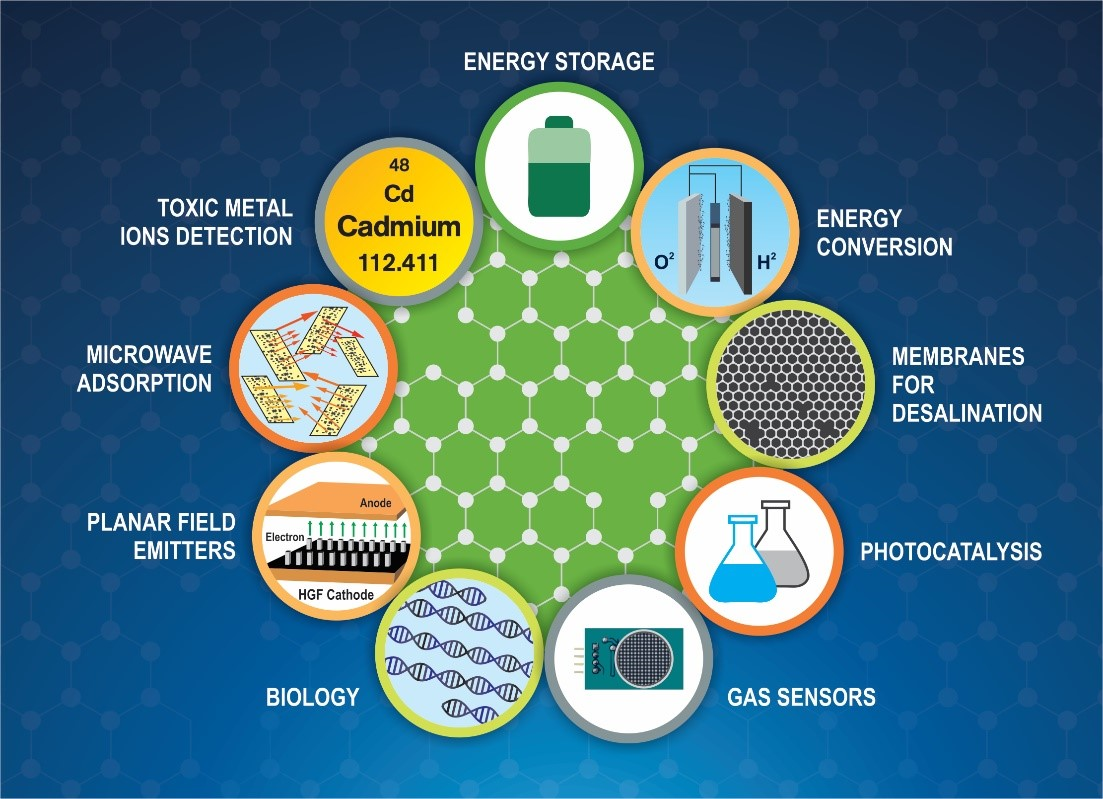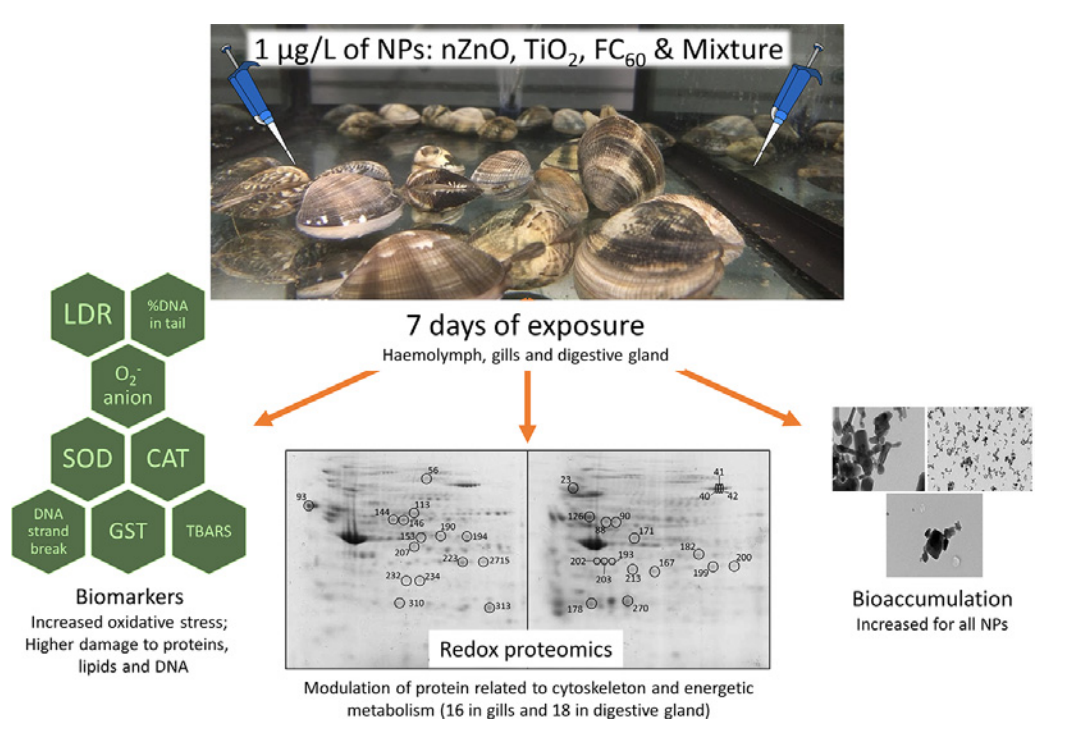
- Photo caption: The multifunctional applications of holey graphene
A review paper by Khalifa University researchers Dr. Abhishek Lokhande, Postdoctoral researcher, Dr. Issam Qattan, Associate Professor of Physics, and Dr. Shashikant Patole, Assistant Professor of Physics, has been published in the Journal of Materials Chemistry A, covering everything to do with porous graphene. Their review discusses the state-of-the-art pore generation techniques, underlying mechanisms of action, advantages, disadvantages and applications of ‘holey’ graphene.

Graphene is a unique material comprising densely packed carbon atoms arranged in a hexagonal honeycomb lattice—known mostly to the public as the layers of material that make up pencil lead. It is extremely versatile and has potential applications in various fields, particularly thanks to its superior optical, electrical, thermal and mechanical properties.
In its purest form, graphene offers myriad applications. However, in recent years, nanoscale perforation of 2D materials has emerged as an effective strategy to enhance and widen the applications of a material beyond its pristine form.
“With the possible exception of cheese, it is well known that materials have modified properties when their structure is perforated,” said Dr. Patole. “Porous graphene, or holey graphene, is a form of graphene with nanopores in its plane. This unique porous structure enables easy interaction with inorganic or organic species, which has broad applications in water desalination, water treatment, environmental protection, and energy storage systems.”
The performance of the material is affected by the pore size, density, shape, and volume, and usually, uniform pore shape and size distribution is optimal as it leads to enhanced thermal, mechanical and electrical properties.
Graphene-based porous materials are classified into three categories based on the assembled architecture, namely holey graphene, 2D laminar porous graphene, and 3D conjugated interconnected porous structures, with holey graphene showing abundant in-plane pores generated at the basal plane using various perforation techniques. Nanochannels are formed due to the regular and periodic stacking of graphene nanosheets over each other, making interlayer pores through which liquid ions can easily pass.
“By exploiting the combined advantages of holes and graphene, holey graphene-based materials have attracted significant interest,” said Dr. Patole. “They have exceptional properties such as high electrical conductivity and high surface area, which allows holey graphene extremely versatile and able to outperform its pristine form for many applications.”
Porous graphene exhibits distinct properties from its pristine form. Compared to other graphene-based porous materials, holey graphene has an increased surface area, reduced nanosheet stacking, enhanced chemical reactivity and a stronger hydrophilic nature, which means it maximizes contact with water. Additionally, it offers high mechanical strength for superior structural stability, high chemical inertness to avoid contamination issues, high thermal stability for use in rigorous environments, high electrical conductivity for rapid electron transport, and high ion diffusion due to the interlayer channels. By fine tuning the parameters of the pores, porous graphene can be optimised for various applications.
“Holey graphene-based materials can be applied in diverse fields, including electrical energy storage, energy conversion, water desalination, bioseparation, fuel cells, gas sensors, and hydrogen storage and dye degradation systems,” added Dr. Patole. “For further research and development, we need to uncover the prime properties and related potential industrial implications of these materials, as well as suitable generation methods.”
The research team identified the pores as the basis for realizing holey graphene’s potential. However, synthesizing even pristine graphene is complicated. The most scalable methods suffer from the drawbacks of producing materials with inconsistent properties and low purity. Methods that produce high-quality graphene are much more expensive and involve the use of highly sophisticated operational setups and accessories.
“This is why it’s important to develop methods that are easy, cost-effective, efficient and scalable for graphene synthesis,” explained Dr. Patole.
When pristine graphene has been produced, it can be made porous by chemical and physical methods, but hole generation is tricky and its parameters depend on the methods adopted for its intended purpose.
“Generally, the expected pore size should be smaller than the conventional pore size of the naturally available materials,” said Dr. Patole. “However, fabricating porous graphene with well-defined pores is still a challenge as it is quite complex and restricted by our current technological limits.”
Synthesizing holey graphene is also associated with the use of toxic chemicals and the high cost of the starting materials, so novel strategies will be required for its synthesis. The researchers investigated the use of biomass as a starting material, including Bougainvillea flowers and Plumeria rubra leaves, among other approaches.
Besides the major reported applications in supercapacitors, lithium ion batteries, electro-water splitting, and water desalination systems, holey graphene-based materials are also applied in various other applications. Some of these applications include hydrogen storage, dye degradation, organic pollutant separation, and gas sensing. Holey graphene has even been investigated for biological applications, with the researchers highlighting effective performance in non-enzymatic glucose detection in human blood samples and selective bacterial detection.
“Holey graphene-based materials have emerged as versatile materials and have demonstrated superior performance in many applications,” explained Dr. Patole. “With continuous efforts and developments, the commercial application of holey graphene-based materials will surely revolutionize all sorts of applications.”
Jade Sterling
News and Features Writer
27 April 2020






